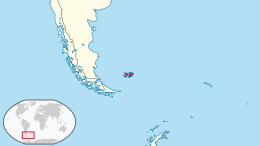Commons:Copyright rules by territory/Falkland Islands/eo
|
Kopirajtaj reguloj: Falkland Islands Shortcut: COM:FALKLAND ISLANDS | |
 | |
 | |
| Durations | |
|---|---|
| Standard | Vivdaŭro + 50 jaroj |
| Fotografaĵo | Publish + 50 years |
| Anonima | Publish + 50 years |
| Other | |
| Freedom of panorama | For architecture, sculptures, and works of artistic craftsmanship |
| Terms run to year end | Jes |
| Common licence tags | {{PD-old-auto}} |
| Traktatoj | |
| Berne convention | 5 December 1887 |
| Univ. Copyright Convention | 27 September 1957 |
| WTO member | 1 January 1995 |
| URAA restoration date* | 1 January 1996 |
| WIPO treaty | 14 March 2010 |
| *A work is usually protected in the US if it is a type of work copyrightable in the US, published after 31 December 1928 and protected in the country of origin on the URAA date. | |
This page provides an overview of copyright rules of the Falkland Islands relevant to uploading works into Wikimedia Commons. Note that any work originating in the Falkland Islands must be in the public domain, or available under a free license, in both the Falkland Islands and the United States before it can be uploaded to Wikimedia Commons. If there is any doubt about the copyright status of a work from the Falkland Islands, refer to the relevant laws for clarification.
Background
The Falkland Islands have had French, British, Spanish, and Argentine settlements at different times. They have been controlled by Britain since 1833. The Falkland Islands is a British Overseas Territory, though Argentine remains claiming sovereignty here. It is self-governing, and its government enacts local laws. These are largely based on British law.
As of 2019, the Falkland Island government lists the Copyright Act 1956 c.74 as being applicable in the Falkland Islands by virtue of the Copyright (Falkland Islands) Order 1963 (S.I. 1963/1037).[1] The United Kingdom government holds a copy of this act as originally enacted.[2]
General rules
Under the Copyright Act 1956,
- Copyright subsisting in a work ... shall continue to subsist until the end of the period of 50 years from the end of the calendar year in which the author died, and shall then expire.[1956 Sec.2(3), 3(4)]
- If the work had not been made public before the death of the author, copyright shall continue to subsist until the end of the period of 50 years from the end of the calendar year which it was made public.[1956 Sec.2(3), 3(4)]
- Where the first publication of a literary, dramatic, or musical work. or of an artistic work other than a photograph, is anonymous or pseudonymous, any copyright subsisting in the work ... shall continue to subsist until the end of the period of 50 years from the end of the calendar year in which the work was first published, and shall then expire.[1956 2nd Sched. Sec.2]
- The copyright in a photograph shall continue to subsist until the end of the period of 50 years from the end of the calendar year in which the photograph is first published, and shall then expire.[1956 Sec.3(4b)]
Freedom of panorama
Vidu ankaŭ: Commons:Freedom of panorama/eo
![]() (for architecture, sculptures, and works of artistic craftsmanship) and
(for architecture, sculptures, and works of artistic craftsmanship) and ![]() (for other types of artistic works), in the similar manner and rules as the United Kingdom freedom of panorama.
(for other types of artistic works), in the similar manner and rules as the United Kingdom freedom of panorama.
The Copyright Act 1956 c. 74 provides freedom of panorama at Section 9, General exceptions from protection of artistic works.
- The copyright in a work to which this subsection applies which is permanently situated in a public place, or in premises open to the public, is not infringed by the making of a painting, drawing, engraving or photograph of the work, or the inclusion of the work in a cinematograph film or in a television broadcast.[1956 Sec.9(3)]
- (This subsection [Sec.9(3)] applies to sculptures, and to such works of artistic craftsmanship as are mentioned in paragraph (c) of subsection (1) of section three of this Act.)
- The copyright in a work of architecture is not infringed by the making of a painting, drawing, engraving or photograph of the work, or the inclusion of the work in a cinematograph film or in a television broadcast.[1956 Sec.9(4)]
- Without prejudice to the two last preceding subsections, the copyright in an artistic work is not infringed by the inclusion of the work in a cinematograph film or in a television broadcast, if its inclusion therein is only by way of background or is otherwise only incidental to the principal matters represented in the film or broadcast.[1956 Sec.9(5)] (de minimis inclusion of works not permanently situated in public spaces only in television and films)
- The copyright in an artistic work is not infringed by the publication of a painting, drawing, engraving, photograph or cinematograph film, if by virtue of any of the three last preceding subsections the making of that painting, drawing, engraving, photograph or film did not constitute an infringement of the copyright.[1956 Sec.9(6)]
Vidu ankaŭ
- Falkland Islands
- Commons:Copyright rules by territory/British Overseas Territories/eo
- Commons:Copyright rules by territory/United Kingdom/eo
Citations
- ↑ Copyright Act 1956 c. 74. Falkland Islands Government.
- ↑ Copyright Act 1956. United Kingdom (1956).